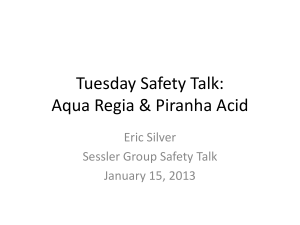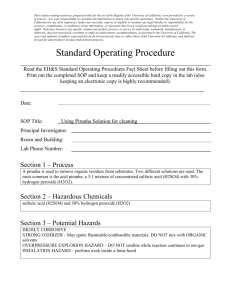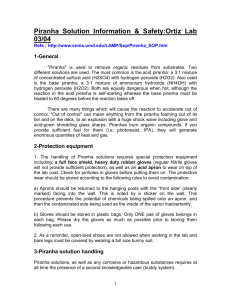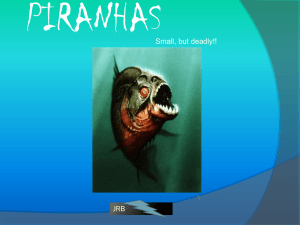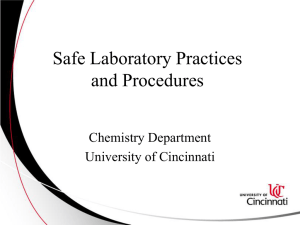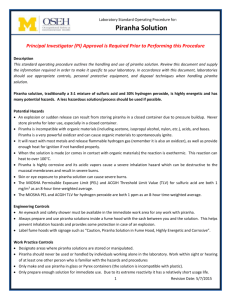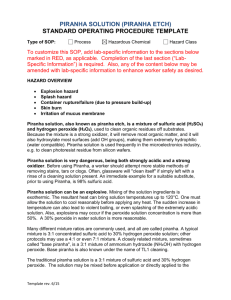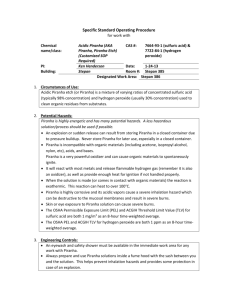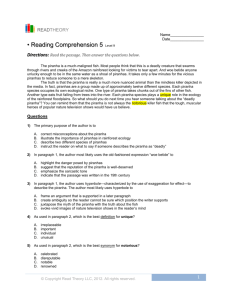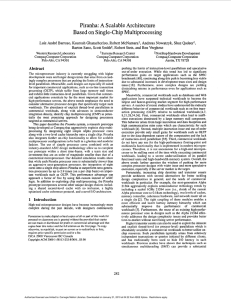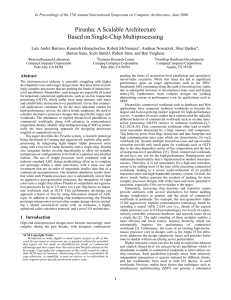piranhaetchsop - University of Delaware
advertisement
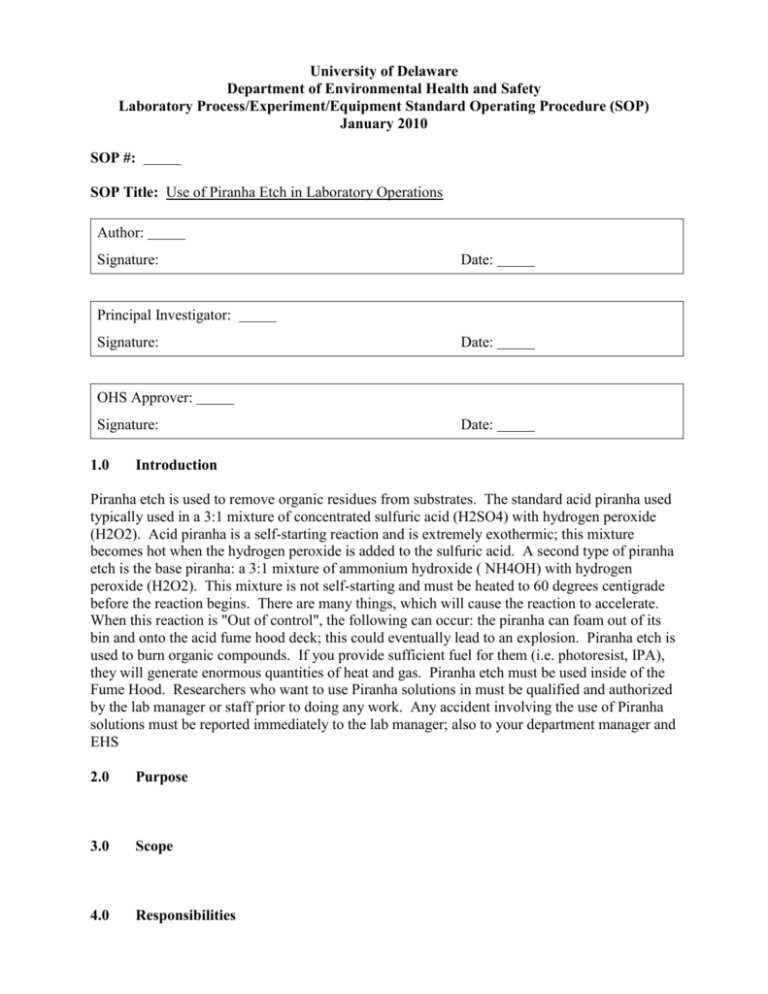
University of Delaware Department of Environmental Health and Safety Laboratory Process/Experiment/Equipment Standard Operating Procedure (SOP) January 2010 SOP #: SOP Title: Use of Piranha Etch in Laboratory Operations Author: Signature: Date: Principal Investigator: Signature: Date: OHS Approver: Signature: 1.0 Date: Introduction Piranha etch is used to remove organic residues from substrates. The standard acid piranha used typically used in a 3:1 mixture of concentrated sulfuric acid (H2SO4) with hydrogen peroxide (H2O2). Acid piranha is a self-starting reaction and is extremely exothermic; this mixture becomes hot when the hydrogen peroxide is added to the sulfuric acid. A second type of piranha etch is the base piranha: a 3:1 mixture of ammonium hydroxide ( NH4OH) with hydrogen peroxide (H2O2). This mixture is not self-starting and must be heated to 60 degrees centigrade before the reaction begins. There are many things, which will cause the reaction to accelerate. When this reaction is "Out of control", the following can occur: the piranha can foam out of its bin and onto the acid fume hood deck; this could eventually lead to an explosion. Piranha etch is used to burn organic compounds. If you provide sufficient fuel for them (i.e. photoresist, IPA), they will generate enormous quantities of heat and gas. Piranha etch must be used inside of the Fume Hood. Researchers who want to use Piranha solutions in must be qualified and authorized by the lab manager or staff prior to doing any work. Any accident involving the use of Piranha solutions must be reported immediately to the lab manager; also to your department manager and EHS 2.0 Purpose 3.0 Scope 4.0 Responsibilities Please select the general categories of personnel who could obtain approval to perform the process or use the experiment: 1. Principal Investigator 4. Technical Staff 6. Other (Describe): 5. 2. Graduate Students 3. Undergraduates Post Doctoral Employees Please list the specific personnel (Attach an addendum to this form for additional personnel): 1. Trained Initial Training Date: 2. Trained Initial Training Date: 3. Trained Initial Training Date: 4. Trained Initial Training Date: 5. Trained Initial Training Date: The Principal Investigator will update this section when any personnel changes occur. If changes occur, document the changes (include the record of training of additional personnel) in the laboratories files and submit an addendum to the University Chemical Hygiene Officer with all training documentation. 5.0 Hazards 6.0 Hazard Control Measures and Limitations Process or experiment shall be performed only in the following designated areas. Check all that apply: 1. Demarcated Area in Lab (Describe): 2. Fume Hood 4. Other (Describe): 7.0 3. Glove Box Personal Protective Equipment All personnel are required to wear the following personal protective equipment whenever performing the process or experiment: 1. Proper Laboratory Attire (Pants or dresses/shorts below the knees, sleeved shirt, closedtoe shoes) 2. Safety Glasses 3. Lab Coat Personnel may be required to wear other Personal Protective Equipment when working with this material. The Principal Investigator should contact the University Chemical Hygiene Officer to discuss the selection of chemical protective clothing (aprons, suits and gloves) and respirators. Please check all that apply: 1. Chemical Safety Splash Goggles 3. Chemical Protective Gloves (Describe): Nitrile under gloves and 22 mil Neoprene 4. Chemical Protective Clothing (Describe): 5. Chemical Protective Splash Apron (Describe): Neoprene or Butly Rubber 6. Respirator (Type): 7. Other (Describe): 8.0 2. Face Shield Procedural Steps 1. Whenever handling Piranha, only use glass containers (preferably Pyrex). Containers used during the experiment must be very clearly labeled. All work must be done under the flow hood. You MUST make others present in the laboratory aware of your using the Piranha mixture. 2. Mix the solution in the fume hood with the sash between you and the solution. Wear full protection gear as described above. 3. When preparing the piranha solution, always add the peroxide to the acid. The H2O2 is added immediately before the etching process because it immediately produces an exothermic reaction with gas (pressure) release. If the H2O2 concentration is at 50% or greater, an explosion could occur. 4. Piranha solution is very energetic and potentially explosive. It is very likely to become hot, more than 100 degrees C. 5. Substrates should be rinsed and thoroughly dried before placing them in a piranha bath. Piranha etch is used to remove photoresist and acetone residue, not the compounds themselves. 6. Leave the hot piranha solution in an open container until cool. When the solution has cooled to room temperature pour it into the Corrosive Justrite PIRANHA labeled waste container. Piranha continues to give off pressurized gas. 7. Never store hot piranha solutions. Piranha stored in a closed container will likely explode. 8. Adding any acids or bases to piranha or spraying it with water will accelerate the reaction. This includes Photoresist, which is a strong base. 9. Mixing hot piranha with organic compounds may cause an explosion. This includes acetone, photoresist, isopropyl alcohol, and nylon. 10. Do not store wash bottles containing organic compounds in the fume hood. 11. Waste Disposal a. The primary hazard from storage of piranha etch waste is the potential for gas generation and over pressurization of the container when the solution is still hot. If you store the hot solution in an airtight container, it can explode! b. Therefore, prior to storing your waste piranha solution, it must be stored in a Corrosive Justrite Waste Container. c. Contact EHS to for information on Corrosive Justrite Waste Container. d. Elementary neutralization and sewer disposal of this waste stream may be possible. Contact EHS for specifics and approval. 12. Do not store piranha. Mix fresh solution for each use. Excess solution should be disposed as explained above. 13. Other Procedural Steps: 9.0 Training Requirements 1. Review of current MSDS 2. Chemical Hygiene/Right-To-Know 3. Chemical Waste Management 4. Review of the OSHA Lab Standard 5. Review of the Chemical Hygiene Plan 6. Special training provided by the department/supervisor 7. Review of the departmental safety manual if applicable 8. Safety meetings and seminars 9. One-on-One hands-on training with the Principal Investigator or other knowledgeable laboratory personnel. 10. Other required training topics: a. 10.0 Emergency Procedures 1. Any exposure to Piranha or its vapor is severe and dangerous. The victim should be removed from the contaminated area, placed under a safety shower while emergency personal are contacted at 911. 2. All contaminated clothing should be removed immediately with appropriate gloves and safely discarded. 3. In case of contact with the skin, the affected area must be immediately rinsed with large amounts of water from the emergency shower for at least 15 min. 4. In case of contact with the eye, irrigate the eye for at least 15 minutes at the eyewash, keeping the eyelids apart and away from eyeballs during irrigation. Place ice pack on eyes until reaching emergency room. 5. Inhalation of hot or cold Piranha vapors will severely burn the upper respiratory tract. Conscious persons should be assisted to an area with fresh, uncontaminated air. Seek medical attention in the event of inhalation; coughing or tightness in the chest may result. Symptoms may be delayed. 6. A current copy of the MSDS must be sent to the hospital with the emergency personnel. 7. Other emergency procedures: 11.0 Special Procedures 12.0 Attachments

